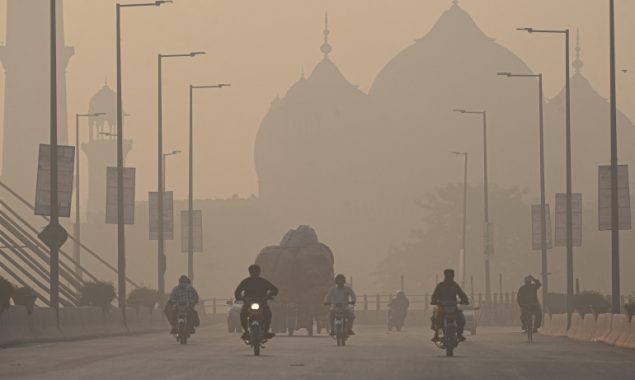
Commuters ride along a road amid smoggy conditions in Lahore. Photo: AFP
Since the last two weeks Lahore has been suffering from the highest levels of toxic air in the world, according to the United States Air Quality Index (AQI). The US Environmental Protection Agency regards air quality satisfactory if the AQI is under 50, meanwhile, the AQI in Lahore has been averaging between 200 and 250, which is categorised as very unhealthy.
However, this is not an uncommon occurrence for the provincial capital, with the city regularly ranking at the top of global pollution rankings. The situation is particularly worse in the winter season between October and February – normally referred to as smog season.
According to the National Geographic, smog is a form of air pollution that reduces visibility, and is a mix of smoke and fog, which historically comes from burning coal in the winter. However, the smog we witness today is photochemical smog, which according to the scientific publication is, “produced when sunlight reacts with nitrogen oxides and at least one volatile organic compound (VOC) in the atmosphere. Nitrogen oxides come from car exhausts, coal power plants, and factory emissions, while VOCs are released from gasoline, paints, and many cleaning solvents. When sunlight hits these chemicals, they form airborne particles and ground-level ozone—or smog.”
Read more: LHC pulls up govt officials over rising smog, pollution
Simply put, in the winter, when the brick kilns in Lahore burn most constantly and when farmers in the wider Punjab province set ablaze the remnants of crops, a large amount of smoke is released into the air. This smoke mixes with the dense fog that occours in the winter months in the region and creates the hazardous, unbreathable smog that makes headlines across the nation.

Graphic Source: iqair.com
Public attention
According to environmental experts the cause of smog is historic in nature and based on years-long pollution cycles caused mostly by the transport sector and industries. It is not an isolated set of incidents that occur purely in the winter and then stops in summer. It is simply that the occurrent pollution becomes stagnant in the air due to the fog in the winter.
Despite this, the global and the national climate activists only took notice of the issue in as late as 2017. This is because there was no actionable air quality data before this time, and data collection only occurred once a network of citizen-operated sensors began to monitor fine Particulate Matter (PM2.5) and report the data in real time. Following this grass-roots data collection the intensity of Lahore’s air pollution came to light, causing widespread public concern, media attention and calls for government intervention.
Read more: ‘We thought he had Covid but it was smog’, life in polluted Pakistan
A public interest petition was filed in Lahore High Court (LHC) in November of the same year, calling for a review of the provincial government’s response to the ongoing smog in the city. Following this the LHC ordered the Punjab government to prepare an updated smog response plan and publish daily, and hourly, pollution updates as non-states actors had been doing. This led to the Punjab Environment Protection Council to approve a Smog Action Plan and adopt an AQI classification system.
Neighbouring pollution
While Lahore has been ranked as one of the most polluted cities in the world over the course of this year, there happens to be another very polluted metropolis right next door. Delhi happens to suffer from some of the highest levels of year-round pollution in the world.
Being the capital of India, Delhi is subject to high levels of pollution high PM2.5, making the air in the city toxic and unbreathable. The current population of the city is estimated at 30.2 million people, as of 2020, who all happen to be squeezed into 1,484 kilometres square. This aids the city’s extremely high population density. Delhi continues to fall in the ‘unhealthy’ bracket of the AQI. While Lahore faces a similar description currently, the situation in Delhi is ‘unhealthy’ across the year, with winter months edging into hazardous.
For a city to be in this state year-round there have to be extremely high levels of pollution on the ground. It is a well-known fact that the Indian capital struggles with population density, population growth, urban diseases and crumbling residential and commercial infrastructure, which is all a symptom of mass-industrialisation and economic development. More residents has meant that there are more cars on the road, with increased private and public transports, including old buses and trucks that do not have catalytic converters. The estimated 11.2 million registered motor vehicles in the city generate an extremely high volume of pollution. This, coupled with crop burning, is the main reason that Delhi usually tops the pollution chart.
Read more: LHC asks for plan to maintain traffic in Lahore during smog
However, in the past month the situation has worsened. The Indian Supreme Court has called for a lockdown in the capital citing health concerns over the increasing air pollution. The Court order the relevant authorities to halt all non-essential travel on the roads, close offices and schools in the area and imposed Section 144 of the India Penal Code, which pertains to the prohibition of the gathering of more than four people.
Effects of smog
Smog is a deeply injurious substance that can lead to many health complications in those exposed to it. In the Great Smog in London in 1952 as many as 12,000 people died as a result of breathing in harmful toxins.
This type of air pollution regularly leads to coughing, allergies and irritation of the eyes, chest, nose and throat, this is because smog irritates the respiratory system and leads to coughing and wheezing. According to health professionals, the effects should only last for a few days after exposure to smog, however even the symptoms disappear the toxins from the smog as it damage one’s lungs in the long-term. Smog is also active in aggravating asthma and causing acute difficulty in breathing. In severe cases an individual may suffer from ailments such as, bronchitis, pneumonia and emphysema etc. These are some of the lung conditions linked to the damage of the lining of the lungs.
Another terrible predilection of smog is the higher likelihood of premature deaths because of respiratory diseases and cancer. According to the World Health Organisation, cumulative exposure to smog enhances the chances of contracting respiratory diseases and premature death. Smog also leads to birth defects in unborn children and low birth weights in newborns. Pregnant women, when exposed to smog, are more likely to give birth to children with Spin Bifida and brain defects. The overcast caused by smog also reduces exposure to the sun, and therefore essential nutrients like Vitamin D, leads to the development of rickets.
How to stay safe

Graphic Source: iqair.com
As public health and safety are serious concerns that need to be met with concrete solutions, it begs the question: how can we get rid of, or at the very least minimise, smog? Prime Minister Imran Khan has stated that it is his priority to combat pollution and move towards a climate conscious Pakistan. As such, Punjab Green Development Program (PGDP) project, has planned to establish 10 air quality monitoring stations in Lahore. However, the PGDP’s efforts, while well-intentioned, are doing little to help the people of provincial capital.
To really combat smog, the Federal and Provincial governments but take actionable steps towards reducing pollution. One of the most prominent of these is reducing its investment in dirty energy. By opting for renewable energy sources, they can considerably reduce emissions in the region. Furthermore, managing vehicular and industrial emissions is key in reducing urban smog. This ties in with the use of clean energy. By encouraging importers to bring in electric cars, and cars with catalytic converters, vehicular emissions can be reduced. Similarly, banning industries from using fossil fuels and switching towards renewable energy sources will help reduce the level of carbon and soot emissions in the city. This needs to be couple with an efficient energy usage system. By using less energy we can reduced wastage and subsequently reduce the production of gaseous emissions that lead to the formation of smog.
Read more: Govt not planning to close educational institutions due to smog: Shafqat Mahmood
Better waste management is also the key to reduce smog in Lahore. Currently, landfill and crop burning happen to be one of the major contributors toward creating the soot part of smog. While nothing can be done about the natural fog, the smoke produced by these burning activities can be actively reduced and monitored.
An innovative solution
With no-end in sight during the winter months, citizens find themselves wondering if every successive winter in Lahore is going to be like this? Scientists at the Punjab University’s (PU) Centre for Integrated Mountain Research, say there is hope yet. According to the Centre’s Director Professor, Munawer Sabir, a solution to the deadly smog engulfing the urban city is artificial rain. The team is heading to the Khanspur mountainous area to carry out the experiment, which they believe would dissipate the smog.
“If we manage to create artificial rain for five to six hours in Lahore in [the winter] season then we can counter the impact of the smog as the dust and other elements posing risks to people’s health would be washed away,” said Professor Sabir. The team plans to carry out artificial rain tests in Lahore after November 19, following the success of the first trial.
Catch all the Pakistan News, Breaking News Event and Latest News Updates on The BOL News
Download The BOL News App to get the Daily News Update & Follow us on Google News.




